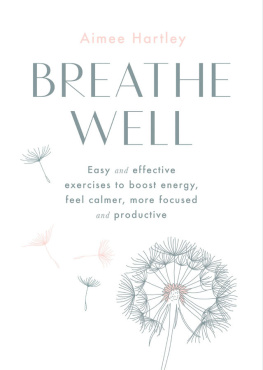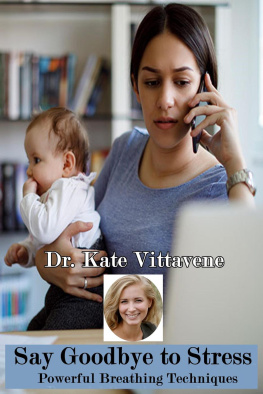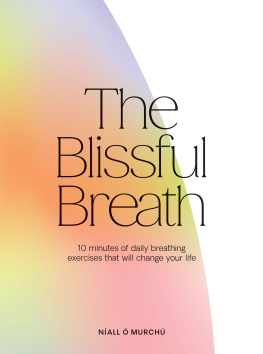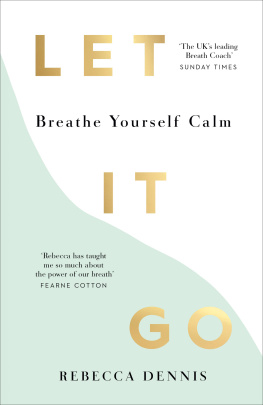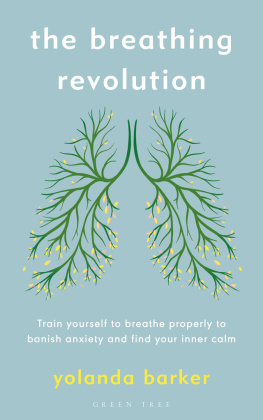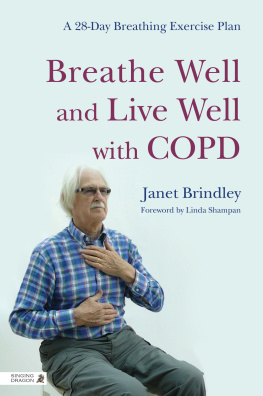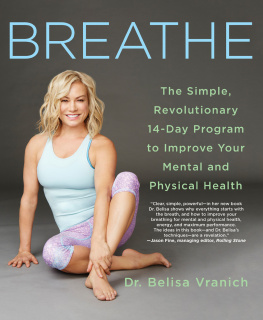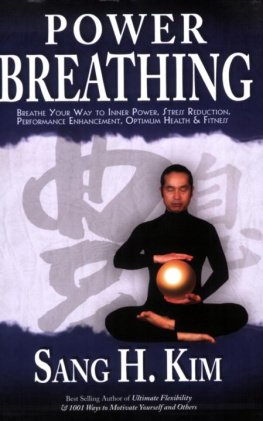
CONTENTS
HOW TO USE THIS EBOOK
Select one of the chapters from the and you will be taken straight to that chapter.
Look out for linked text (which is in blue) throughout the ebook that you can select to help you navigate between related sections.
You can double tap images to increase their size. To return to the original view, just tap the cross in the top left-hand corner of the screen.
INTRODUCTION
You breathe, on average, around 17,000 times a day (one breath = an inhale and an exhale). If youre one of the lucky ones, and make it to the grand old age of 85, you will have around 520 million breaths to enjoy throughout your lifetime. Breathing is your very first, and will be your last, life experience. And everything in between.
For all these breaths, how does it feel to switch from the more commonly used phrase of take a deep breath to a new way of thinking about what it is we are doing when we breathe? What if you can learn to make a deep breath? And cook up a whole new way of living your life? Throughout this book I will share how, by engaging all parts of your respiratory system, you can improve the way you feel, simply by adjusting the way you breathe.
You will first bring awareness to how you breathe and learn how this influences all aspects of your life. You can then practise different breath techniques to help you feel more calm and energized. You will learn how to engage in a full diaphragmatic breath to lower your blood pressure, boost your circulation, improve your digestion and reduce feelings of stress. You can sharpen your concentration, learn the art of being present, understand how to release and heal emotions, and explore the deeper sides of your nature, all through fine-tuning and mastering your breathing.
Within these pages you will read advice, learn new breath methods, gain inspiration from respiratory consultants, world-class teachers, sleep experts, naturopaths, scientists, doctors and psychologists. As the title suggests, breathing well is the key to feeling better, and building a regular conscious breath practice, using different breath techniques, can help you to adopt an internal compass that will help you to navigate your way on the rollercoaster journey that is life.

THE FOUR DIRECTIONS OF CONSCIOUS BREATHING

If we breathe well in all four directions of the respiratory system, pelvic and diaphragm (south), nose, throat and upper chest (north), all lobes of the left and right lungs and ribcage (east and west) we can experience the fullness of life, with a balanced state of mind.
Sometimes our first conscious breath (the one which we bring new awareness to) can be profound.
HEALTHY BELLY BREATH
When describing a full, healthy breath, I often choose the image of a toddler walking around with a big rounded belly. We can visualize the diaphragm descending fully on an inhalation, gently moving the lower organs down, which creates an unapologetic protruding of the lower belly. The entire torso moves freely with each breath and theres no muscular tension. You will never see toddlers pulling in their stomachs for photogenic purposes!
WHAT TAKES AWAY OUR HEALTHY BREATH?
Many aspects of our lives can impact negatively on the way we breathe. From traumatic birth experiences, unsettled family environments, the pressure to achieve the perfect figure (pulling in our bellies can trigger feelings of anxiety), to unhealthy living and working environments and the quality of the food we eat, our lifestyle can take its toll on our ability to breathe well.
Ive observed the breath patterns of many children, including my own, and have noticed that we seem to lose a vital connection to our breath in the very early years of starting school. From wandering free as a toddler, breathing deeply, expressing emotions fully and living in the moment, playing and exploring without the distractions of a more mature mind, to then having to adhere to an educational regime. Sitting down for long periods, reduced playtime, along with having to deal with new social interactions and figures of authority (and the pressure of early years testing), the school environment can, for some, act as a prime catalyst for the beginnings of a dysfunctional breath pattern.
Other factors can cause our body to enter the stress response, including the quality of the air we breathe. For those living in a city, where polluted air is (tragically) the norm, I often wonder if rising stress levels are a result of us breathing less, as we subconsciously and sporadically begin to hold our breath to prevent toxins entering the body. These smaller, shallower breaths can become our default breath pattern and we can spend more of our time in an anxious fight or flight state. Over time this can be detrimental to our overall physical and mental health recent research reveals that teenagers exposed to polluted air are more likely to suffer from depression.
Then theres our internal landscape, our emotions. When we dont feel able to express or engage with our feelings, our immediate reaction is to hold our breath, which prevents the natural flow of this energy and creates tension in the body. If these emotions remain unexpressed, tension can build up in the body, often within the core and respiratory muscles and we can start to develop and sustain an inhibited breath pattern.
There are more innocent factors too simple everyday choices like the clothes we wear can impede a full diaphragmatic breath. Tight jeans, corset-like bras, squeezed belts and restrictive fitted suits can all limit the range and depth of our breath. (Especially if worn as one outfit!)

HOW DO WE LEARN TO BREATHE WELL?
The foundation of any breath practice should be re-establishing how to breathe in a full, healthy way. Subconsciously, we all know how to breathe well, we just need to spend a little more time developing a practice to remind ourselves how. This is what is should feel like:
Inhaling through the nose, the diaphragm descends and the belly, lower torso and lower back expand softly and fully. There should be a silent, effortless quality to the breath.
During the inhalation there can be an awareness of the pelvic diaphragm descending in unison with the respiratory diaphragm.
The ribs expand in east and west directions.
The upper chest and upper back lift slightly near the peak of the inhalation.
On exhaling, the air should exit via the nose, and the belly returns to its resting position in a calm manner.
The ribs will return to resting position as the lungs deflate.
The upper chest will also return to its rest position.
The rhythm of the breath should be flowing with no holding on. The inhalation should feel expansive, energizing and effortless. The exhale should be silent and smooth. A full, healthy breath should feel graceful and enlivening. The breath should support a perfect posture and vice versa.
The wisest one-word sentence? Breathe.
TERRI GUILLEMETS
THE BENEFITS OF BREATHING WELL
The average adult breathes at a pace of around 12 breaths per minute. Each and every one of these breaths can have a positive ripple effect on all the systems of the body.
Next page
